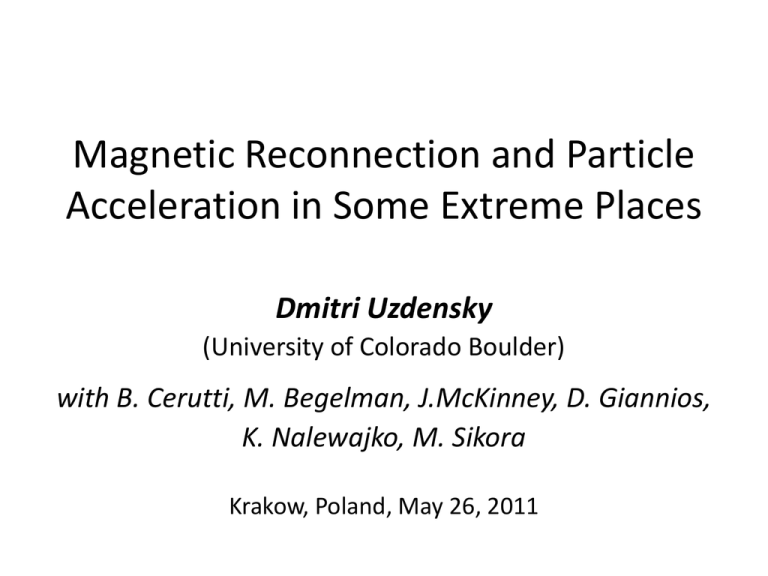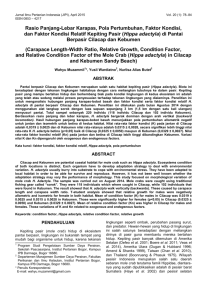Magnetic Reconnection, Particle Acceleration, and Radiation in
advertisement

Magnetic Reconnection and Particle Acceleration in Some Extreme Places Dmitri Uzdensky (University of Colorado Boulder) with B. Cerutti, M. Begelman, J.McKinney, D. Giannios, K. Nalewajko, M. Sikora Krakow, Poland, May 26, 2011 Dissipation and emission in relativistic astrophysical flows Crab M87 GRB • relativistic flows shine, one way or another. • Often, radiative cooling time is << travel time from central source in-situ particle acceleration. Dissipation Mechanisms AVAILABLE FREE ENERGY Magnetic (Poynting flux) Bulk Kinetic - longitudinal: shocks (e.g., termination shock, colliding shells) - transverse: shear (KH) instability turbulence (e.g., boundary btw fast jet and slower wind) Magnetic reconnection STRUCTURE current sheets: - advected from central engine - developing spontaneously, (e.g., kink MHD instabilities) Introduction: Magnetic Reconnection • Magnetic reconnection is a rapid rearrangement of magnetic field topology • Reconnection often results in violent release of magnetic energy and its conversion to: – electron and ion heating – bulk kinetic energy – non-thermal particle acceleration Traditional Magnetic Reconnection in the Solar System Reconnection: main questions • Current sheet formation and reconnection onset: how/when does reconnection start? • Reconnection rate: how rapid is it? • Released energy partitioning: – kinetic vs. thermal vs. nonthermal particle acceleration – electrons vs. ions Traditional paradigm: steady laminar reconnection 2 regimes based on plasma collisionality: • Collisional (resistive): δsp > di, • Sweet—Parker layer thickness: δsp vs. di, ρi, • Collisionless (e.g., Hall) : δsp < di, • Ion skin depth: (sims by Cassak et al. 2005) Sweet—Parker ---- SLOW (cE ~ S-1/2 B0 VA, S = LVA/η) • • Petschek --- FAST (cE ~ 0.1 B0 VA ) Modern paradigm: nonsteady, dynamic plasmoiddominated reconnection (Loureiro et al. 2007, 2009; Lapenta 2008; Samtaney et al. 2009; Daughton et al. 2009; 2011; Bhattacahrjee 2009, Cassak et al. 2009, 2010; Uzdensky et al. 2010; Huang et al. 2010) Loureiro et al. 2011 • Long current sheets (with L/δ > 100) are tearing-unstable and break up into chains of plasmoids (flux ropes in 3D). • Statistically steady-state self-similar plasmoid hierarchy (Shibata & Tanuma 2001) develops with fast reconnection rate even in collisional plasma): cE ≈ 0.01 B0VA . • The hierarchy provides a route towards small scales and facilitates transition to collisionless reconnection (with cE ≈ 0.1 B0 VA ) • Collisionless reconnection in large systems is also plasmoid-dominated Daughton et al. 2011 Conventional Reconnection Research: Conditions: Main Applications: • Electron-ion plasmas • Non-relativistic • Non-radiating • Solar corona • Earth magnetosphere • Laboratory plasmas In contrast, in high-energy astrophysical reconnection, radiation is often important !! Radiative reconnection is in its infancy (Dorman & Kulsrud 1995; Jaroschek & Hoshino 2009; Giannios et al. 2009; McKinney & Uzdensky 2010; Uzdensky & McKinney 2011; Uzdensky 2011; Nalewajko et al. 2011) Main topic: Reconnection in high-energy radiative astrophysical environments • Radiation effects: – radiation pressure, – radiative cooling, – Compton resistivity, – radiative viscosity. • Other important effects: – Special-relativistic effects – Pair creation – QED in ultra-strong B-fields Examples of extreme reconnection in astrophysics: radiative reconnection at Peta-scale I. Crab PWN flares II. Blazar TeV flares III. GRB jets IV. Magnetar (SGR) flares Low B collisionless 10-3 G Crab collisional 1G 108 G Blazars GRB High B 1015 G magnetars I. Reconnection of magnetar fields • The most extreme example of high-energydensity astrophysical reconnection • Applications: – SGR flares; – central engines of GRBs and SNe. Motivation: Magnetar (SGR) Flares • Magnetars: isolated neutron stars with Peta-Gauss fields. • Soft Gamma Repeaters (SGRs): magnetars exhibiting powerful (up to 1044 − 1046 ergs in ∼ 0.3 sec) γ-ray flares. Reconnection interpretation: Thompson & Duncan 2001; Lyutikov 2003, 2006 Physics of ultra-strong field reconnection Critical Quantum Magnetic Field • Critical Quantum Magnetic Field: • Magnetic Energy Density: Radiation and Pair Production • Pressure balance (if no guide field) across layer or energy conservation determine central temperature, T0: Pair Production • Copious pair production (Saha equilibrium): where • Current layer is dressed in optically-thick pair coat! Role of Pair Production: Extremely high pair density: • makes reconnection layer optically thick, and yet radiative cooling time may be < advection time radiative transfer problem! • makes the layer highly collisional radiative resistive MHD should apply! Pairs trap radiation: • High pair density ⇒ layer is optically thick: τ = n σ δ >> 1 – in sharp contrast with conventional reconnection. • Yet, photon diffusion time across layer may be << global advection time along layer: if τ << L/ δ • Radiative cooling may dominate over advection! • Fundamentally, the reconnection problem becomes a radiative transfer problem! (c.f., accretion disks) Collisionality of Reconnection Layer • EXAMPLE (Uzdensky & MacFadyen 2006; see also McKinney & Uzdensky 2010): • B0 = 0.5 B∗ = 2 x 1013 G, • Spitzer resistivity: T ∼ 300 keV, ne ∼ 2 x1029 cm−3. ηS = 0.1 cm2/sec (photon drag gives comparable contribution) • Typical global scale: L = 10 km • Lundquist number: S = Lc/ηS ∼ 1018 • Sweet-Parker layer thickness: • δSP ≪ L, • but δSP = L S−1/2 ≃ 10−3 cm. δSP ≫ de , ρe ∼ 10−10 – 10-10 cm, λ e,mfp ∼ 10−6 cm. Thus, reconnection layer is highly collisional, resistive MHD (with Compton drag) should apply! II. GRB Jets (McKinney & Uzdensky 2010; Jon McKinney’s talk yesterday!) Reconnection Switch to Trigger GRB Jet Dissipation (McKinney & Uzdensky 2010) • Reconnection current layers near central engine are collisional. • At larger distances, B drops, temperature drops, pairs recombine, density drops. • Somewhere at peta-cm distances, reconnection layer becomes collisionless switch to faster energy dissipation III. Reconnection in Blazar Jets: jet-in-a-jet (Giannios, Uzdensky, Begelman 2009 (Blazars) , 2010 (M87) Nalewajko, Giannios, Begelman, Uzdensky, & Sikora 2011) Extremely Rapid TeV variability in blazars Doppler factor crisis • Variability timescale τ < 5 min at γ-ray luminosity L > 1046 erg/s. BL Lac PKS 2155-304 (z = 0.116) July’06 HESS VHE (>200 GeV) outburst • Pair-production opacity constraint for single-zone models Γ ~ 50 (Begelman, Fabian, & Rees 2008). • AGN unification models and VLBI kinematics of pc-scale jet in BL Lacs imply Γ ~ 10. PKS 2155-304 (image by J.J. van Ellinckhuijzen) IV. Gamma-ray flares in Crab PWN DAU, B. Cerutti, & M. Begelman 2011 – see Benoit Cerutti’s poster! Gamma-Ray Flares in the Crab September 2010 AGILE/FERMI γ-flare Simple Estimates • Observational constraints: – Flare duration: τ = 1 day --> l ~ 3 x 1015 cm – Photon energy: > 100 MeV --> γ9 ~ 3 B-3-1/2 -- PeV!! – Isotropic flare energy: E ~ 4 x 1040 erg • Simplest assumptions: isotropic synchrotron emission, no Doppler boosting. • Synchrotron cooling constraint: τflare > τsync B-33/2 τflare,5 > 3 • Flare energetics : Eflare< V B2/8π V48B2-3 > 1 B-3 > 5 (τflare,5)-3/2 • Strong (a few milligauss) magnetic field is required! Main Problem: production of synchrotron emission > 100 MeV challenges classical models of acceleration Maximum electron energy is limited by radiative losses: • Accelerating electric force: facc=eE • Radiation reaction force: frad=2/3 re2 γ2 B2 facc=frad γmax • Synchrotron photon energy: εmax=3/2 γ2max ħ ωc = 160×(E/B) MeV In classical acceleration mechanisms: E<B εmax< 160 MeV (e.g., de Jager et al. 1996; Lyutikov 2010) Possible resolution: relativistic Doppler boosting effect: [e.g. Komissarov & Lyutikov 2010, Bednarek & Idec 2011] εmax=D×160 MeV But required D≈3-4, unlikely for Crab (bulk motion < 0.5 c) [Hester+2002] Another Way Out: Reconnection • εmax=3/2 γ2max ħ ωc = 160×(E/B) MeV • A way out of the Crab flare paradox: relax E < Bperp assumption! • Impossible in ideal MHD (E + v x B/c = 0) • Reconnection layers are a natural place for this to happen. Where could magnetic reconnection operate in the Crab? Pulsar wind Current sheet (striped wind) Polar region - High magnetic field (Z-pinch) - Kink unstable [Begelman 1998] © NASA-CXC-SAO F.Seward et al. Motion of PeV particles • Gyroradius ρ ~ 3 x 1015 cm ~ L motion is controlled only by large-scale electro-magnetic fields: – Reconnecting (x) magnetic field B0 – Reconnection (z) electric field E_z = βrec B0 – Guide (z) magnetic field, Bz (βrec ~ 0.1 in rel. pair recn. even without Hall effect --- Zenitani & Hoshino 2001-2008) What limits the acceleration? • Maximum particle energy is limited by: - accelerating potential available (finite length): - radiation reaction: • Corresponding synchrotron photon energies: Main Idea (Uzdensky, Cerutti, & Begelman 2011; see also Kirk 2004) • Energetic particles travel in relativistic analog of Speiser orbits: – accelerated by reconnection Ez in z-direction; – confined to reconnection midplane by reversing reconnection magnetic field Bx. • We show, by explicit analytical example and direct numerical integration, that orbits shrink towards the midplane. • Particles get focused into the layer, where B is small and hence radiation reaction is reduced. • Particles can reach higher energies and emit photons with ε > εsync,* Numerical Calculation of 3D trajectories (Uzdensky, Cerutti, & Begelman 2011, Cerutti et al. 2011) • Includes: – Finite layer thickness: Bx(y) = B0 tanh(y/δ) – Guide magnetic field: Bz – Radiation reaction force Particle Orbit in 3D Why does this matter? • Eventually particle’s orbit is entirely inside layer: ymax < δ • Inside the layer, B ≈ B0 y/δ < B0 , whereas E = βrec B0 is unchanged. • Thus, particles can get to higher energies before achieving radiation reaction limit: γrad ≈ γrad,* δ/ymax > γrad,* • Can emit above the standard limit: εsync ≈ εsync,* δ/ymax > εsync,* βrec = 0.1 Typical synchrotron photon energy at the end of reconnection layer B0 = 5 mG Bz = 0 l = 4 days Summary • In contrast to traditional solar-system plasmas, in many high-energy astrophysical systems magnetic reconnection and particle acceleration are often affected by radiation. • Radiative reconnection is a new frontier in reconnection research. • Examples: – Magnetar reconnection: highly collisional, optically thick “dressed” layer; – GRB jets: pairs annihilate, photons escape transition to fast collisionless reconnection; – Blazar gamma-ray flares: reconnection minijets to get short time-scales, prompt radiation cooling may be important on global transit time-scale; – Crab PWN gamma-ray flares: radiative drag presents strong, but not insurmountable, difficulties for highest energy particle acceleration necessary to explain > 100 MeV synchrotron photons.


